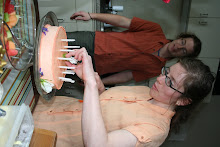
While visiting the Maine zipcode I call my hometowns, we often shopped for staples at the "health food store" (which is neither a food co-op nor a dreadful Whole Foods nor a gourmet shop, but an independent, comprehensive but slightly marginal foodshop of another kind we don't seem to have here in boston), we came across a selection of locally grown dry beans. I immediately spotted the French Flageolet, which I'd been reading about and was eager to try, but there were many others, all with intriguing names: Maine Yellow Eye, Jacob's Cattle, and a beautiful pale yellow-green bean with a sweet shape called Hutterite. This one we bought on appearance alone.
Early in the day we put some to soak, and this evening we made short work of them in the pressure cooker. I am impressed by this method of cooking beans, and really pleased by it! It is quick and efficient. However, I am not at all sure of how it works. I leave the operation of that contraption to my companion, and further discussion of the particulars of pressure cooking will have to wait..
Meanwhile, I stewed some onion slices with thyme, rosemary, salt and pepper in olive oil and later some butter, at high and then low heat, until the onions were very soft. When the beans were done I added them to the onions along with a small amount of the beans' cooking liquid, simmering it and adding more liquid as needed. The beans became quite creamy, and finally it seemed done. The onions had really melted into the sauce, which tasted as though it must have been made with a rich chicken stock of the sort I used to make in my bachelorette days!
As it turns out, Hutterite beans are named in
Slow Food's Arc of Taste. After reading their description of the bean and its availability, I feel especially pleased to have been presented with the opportunity to purchase them--and in such unassuming packaging (just the usual bulk food bags and generic labels--just think how they'd be marketed at the vulgar Whole Foods Market) I am tempted to wax on about Maine agriculture and beans--beans being such a humble and economical food, yet so delicious-- and Maine farmers enabling us to experience these delicious, endangered varieties. Surely these beans are the best value in the Slow Food movement to date!
Broccoli raab is a green we are extremely fond of. I am discouraged that I have to keep buying it in these pink-baled bunches under the label Andy Boy, rather than from a local farmer (I did not see it once at the farmer's markets all summer), but I will keep trying.
In any case: we had from our final CSA share some shallots (the only ones we saw this season!), and I sliced these fine with garlic, a dried red chile, and more thyme. Into the hot olive oil for a while, joined then by blanched and drained raab (rappini), salt, more oil, black pepper.
Both recipes were sourced from Suzanne Goin's Sunday Suppers at Lucques, more or less. The beans were derived from her flageolet recipe (I cut out 2/3 of the steps, I'd say); the raab was followed faithfully. A note on that book: Risking hyperbole, I find that everything I've tried from that book has been unlike anything I've ever tasted before. Way more complex, rich, and flavorful. Even when I do only a few of the things she suggests, good things come of it.
 We've had a number of nice pancake-mornings recently. My dear companion, coming at it with fresh eyes (never a pancake-maker before this!) produced the fluffiest, softest ones I've ever enjoyed...and they were not made with buttermilk.
We've had a number of nice pancake-mornings recently. My dear companion, coming at it with fresh eyes (never a pancake-maker before this!) produced the fluffiest, softest ones I've ever enjoyed...and they were not made with buttermilk. 







